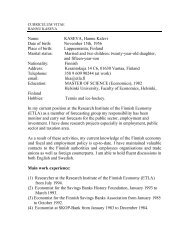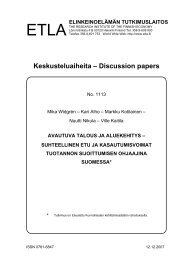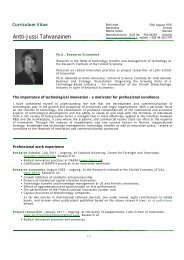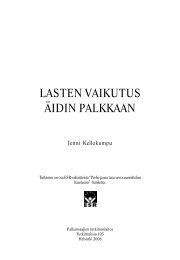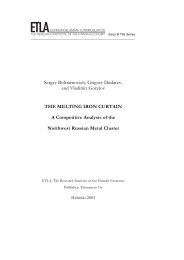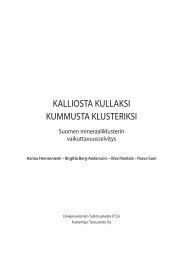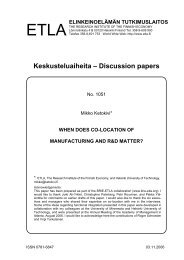Schooling, Family Background, and Adoption: Is it Nature or is ... - Etla
Schooling, Family Background, and Adoption: Is it Nature or is ... - Etla
Schooling, Family Background, and Adoption: Is it Nature or is ... - Etla
Create successful ePaper yourself
Turn your PDF publications into a flip-book with our unique Google optimized e-Paper software.
sents luck. The idea <strong>is</strong> to im<strong>it</strong>ate a lottery where money <strong>is</strong> given to r<strong>and</strong>omly<br />
selected parents at different points in time, <strong>and</strong> then to track the subsequent<br />
school perf<strong>or</strong>mance of their children. If income truly matters we should see<br />
at least two things. First, children should do better in school when parents<br />
are h<strong>and</strong>ed over their prize money when their offspring are still in school.<br />
And second, no effects are expected when parents win their lottery prize <strong>and</strong><br />
children have already left school. Since parents cannot f<strong>or</strong>esee (future) variation<br />
in their income when their children have fin<strong>is</strong>hed school, <strong>it</strong> <strong>is</strong> impossible<br />
to anticipate on <strong>it</strong> while funding their children’s education.<br />
In th<strong>is</strong> paper, <strong>it</strong> <strong>is</strong> th<strong>is</strong> experiment we mimic. We extract r<strong>and</strong>om income<br />
shocks using inf<strong>or</strong>mation on 1975 <strong>and</strong> 1992 income. To be prec<strong>is</strong>e,<br />
we predict log family income in both 1975 <strong>and</strong> 1992 on the bas<strong>is</strong> of observed<br />
human cap<strong>it</strong>al <strong>and</strong> abil<strong>it</strong>y measures, <strong>and</strong> we compute residuals f<strong>or</strong><br />
both years. The estimated equations from which residuals are computed<br />
are rep<strong>or</strong>ted in the first part of Table 3. These new money measures will<br />
depend both on unobserved parental abil<strong>it</strong>y measures <strong>and</strong> luck in the market<br />
f<strong>or</strong> the respective years. If one assumes that unobserved parental abil<strong>it</strong>y<br />
measures are c<strong>or</strong>related, <strong>and</strong> that luck components are not, regressing the<br />
1992 income measure on the 1975 measure should pick up these unobserved<br />
parental abil<strong>it</strong>ies; the residual of th<strong>is</strong> equation proxies that component of<br />
the 1992 family income that reasonably represents luck. And in reverse, if<br />
we regress the 1975 residual on our 1992 measure we obtain a measure f<strong>or</strong><br />
income generated by luck experienced in 1975. The equations from which<br />
the luck components are derived can be found in the second part of Table 3.<br />
Note that th<strong>is</strong> technique purges any income determinant that remains constant<br />
over at least th<strong>is</strong> p<strong>or</strong>tion of the lifecycle; th<strong>is</strong> includes ethnic fact<strong>or</strong>s,<br />
personal<strong>it</strong>y tra<strong>it</strong>s, <strong>or</strong> indeed “structural luck.” 12<br />
Now both luck components are entered into the children’s human cap<strong>it</strong>al<br />
equation as a parental income measure; see Table 4. To estimate the<br />
true impact of parental income we compare the impact on the children’s educational<br />
attainment of r<strong>and</strong>om income shocks experienced when children<br />
are still in school <strong>and</strong> when most children have left school. We observe<br />
that parental income effects fall in 1975 <strong>and</strong> 1992 but remain significantly<br />
different from zero.<br />
By replacing family income w<strong>it</strong>h that income part that <strong>is</strong> generated by<br />
12 Notice that the “luck component” as derived here <strong>is</strong> closely related to the notion of<br />
trans<strong>it</strong><strong>or</strong>y income. To be structurally lucky <strong>is</strong> similar to having a structurally pos<strong>it</strong>ive flow<br />
of trans<strong>it</strong><strong>or</strong>y income, which one would typically interpret as being a part of permanent<br />
income.<br />
14




